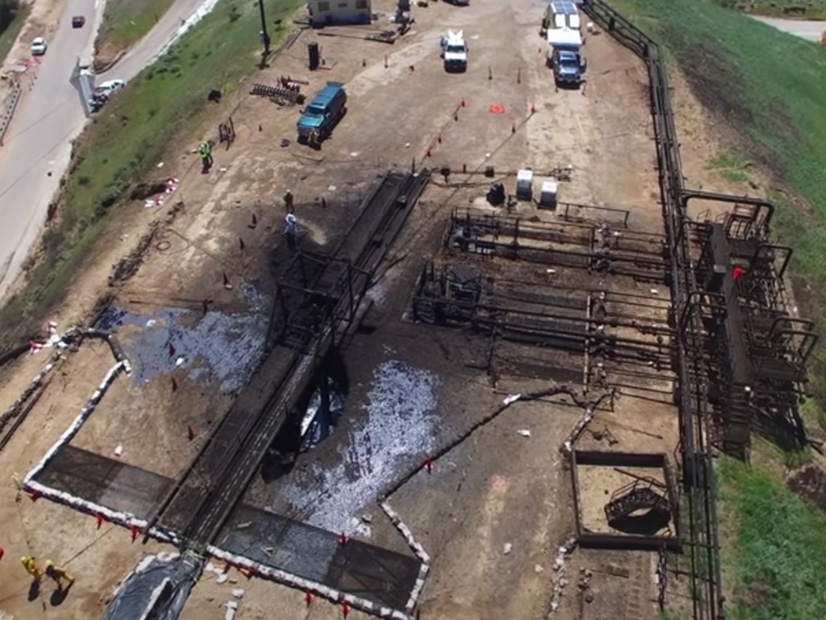
The California Public Utilities Commission issued a decision Thursday adopting a settlement over the massive leak at the Aliso Canyon Natural Gas Storage Facility in 2015 that includes a $71 million penalty against Southern California Gas, the facility’s owner.
As part of the settlement, SoCalGas agreed it would not try to recover $485.5 million in costs related to the incident and it would refund more than $18 million to ratepayers. It also admitted to a violation of Public Utilities Code section 451, which requires public utilities to operate their facilities safely.
The CPUC’s decision approved an agreement between SoCalGas and the CPUC’s Safety and Enforcement Division and Public Advocates Office.
“The settlement agreement … is consistent with the record in that it includes an admission of a safety violation of section 451 for the totality of the Aliso Canyon incident, as well as a significant fine consistent with the magnitude and impacts of the violation,” it says.
CPUC President Alice Reynolds and administrative law judges Jessica Hecht and Marcelo Poirier drafted the decision.
Ratepayer advocates opposed the settlement as premature and possibly inadequate.
The proceeding against SoCalGas was initially “phased,” with “Phase 1 devoted to the number and nature of violations and Phase 2 covering costs, fines and penalties,” The Utility Reform Network (TURN) and the Southern California Generation Coalition (SCGC) noted.
Phase 2 was never litigated, and the settlement bypasses it, TURN and SCGC said.
“Under the settlement, all of the Phase 1 and Phase 2 issues will be resolved, with SoCalGas bearing $610 million in purported monetary remedies in exchange for an admission of a single violation of [the] Public Utilities Code,” they said.
“Despite the extensive litigation that has already occurred, the key discussion of costs assigned to Phase 2 has not yet occurred [and] the record is insufficient to determine that the monetary remedies identified are appropriate,” they said.
The settlement overstates the dollar value of the settlement because “in order for the commission to assess whether the proposed monetary remedies are a sufficient penalty for the conduct at hand, the commission must first assess whether the included dollars would have been appropriate to collect from ratepayers under any circumstances,” TURN and SCGC argued.
The CPUC decision agreed “that a disallowance of cost recovery cannot be considered equivalent to a penalty unless the foregone amount was likely to be recoverable from ratepayers” but said that “in this instance, the settlement agreement clearly protects ratepayers from the risk of litigating hundreds of millions of dollars of potential costs, some of which likely would have been found to be reimbursable by ratepayers.
“In principle, we agree with the opposing parties that the settlement motion may overstate the value of the settlement for ratepayers; nevertheless, we find that SoCalGas’s agreement to forego cost recovery provides some (perhaps non-quantifiable but still real) ratepayer value,” the decision says.
The decision adopting the settlement, known as a presiding officer’s decision, takes effect after 30 days unless a party appeals it or a commissioner requests a public review.
“In case of an appeal or request for review, administrative law judges will assess and potentially modify the decision before presenting it to the commissioners for voting during a public session,” the CPUC said. “Commissioners may also offer an alternate decision for consideration.”
Proposal to Replace
In a separate proceeding, the CPUC has proposed replacing Aliso Canyon, the state’s largest natural gas storage facility, with a combination of non-gas-fired generation, building electrification, energy efficiency and storage. (See California PUC Proposes Aliso Canyon Endgame.)
The facility’s fate has been controversial since a ruptured pipe at the SS-25 well poured more than 100,000 tons of natural gas into the air, leading to a blowout and sickening nearby residents. The leak was contained after four months in February 2016.
After the gas leak, the facility reopened at reduced capacity in July 2017, but in November 2021, the CPUC increased its storage limits by 7 billion cubic feet (Bcf) to just over 41 billion Bcf amid concerns about winter gas supply. At the time, it rejected a plan to increase the allowable storage to 69 Bcf. (See CPUC Approves More Gas at Aliso Canyon.)
On July 28, the CPUC issued a proposed decision that would increase the maximum storage level allowed at Aliso Canyon from 41 billion cubic feet to 69 Bcf “on an interim basis to help secure energy reliability and protect against high natural gas and electric prices.”
The proposal is scheduled to be taken up at the CPUC’s Aug. 31 voting meeting.
